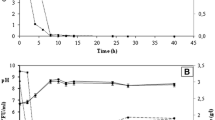Abstract
The capacity for binding magnesium by bakery's yeast strain Saccharomyces cerevisiae No. 102 (Pure Culture Collection, Faculty Food Technology, Warsaw) and fodder yeast strain Candida utilis (ATCC 9950) was investigated in media supplemented with that element. The capacities of C. utilis (ATCC 9950) and S. cerevisiae (No. 102) biomass for binding magnesium were not statistically different in the first 24 h. In the next 24 h of cultivation the cells of C. utilis (ATCC 9950) were still able to bind magnesium ions, whereas those of S. cerevisiae (No. 102) released a part of previously bound magnesium to the medium. The major part of magnesium bound by the cells of C. utilis (ATCC 9950) was accumulated in cytosole. It was opposite to the cells of bakery yeast S. cerevisiae (No. 102) that accumulated magnesium mainly in the cell wall. The cells of C. utilis (ATCC 9950) yeast were smaller and their cell walls were thinner as compared to those of S. cerevisiae (No. 102) yeast. The thickness of the external mannoprotein layers was similar in both strains analyzed.


Similar content being viewed by others
References
Mildred S, Seeling MD (2002) Contemporary Nutr 7:1
Vandergrift B (1991) Bioplexes. In: Lyons LP (ed) Biotechnology in the feed industry. Proceedings of Alltech's Seventh Annual Symposium. Alltech Technical Publications, pp 159–168
Spears JW (1996) Anim Feed Sci Technol 58:151–163
Ashmed HD, Jeppsen RB (1993) In: 8th International Symposium: Trace microelements in man and animals, Abstracts Book: 55
Fly AD, Izquierdo OA, Lowly KR, Baker DA (1989) Nutr Res 9:901–910
Blackwell KJ, Singleton I, Tobin JM (1995) Appl Microbiol Biotechnol 43:579–580
Liu GJ, Martin DK, Gardner RC, Ryan PR (2002) Microbiol Lett 213:231–237
Mowll JL, Gadd GM (1984) J Gen Microbiol 130:279–284
Food and Drug Administration U.S. (2001) Center of Food Safety and Applied Nutrition. Office of Food Additive Safety
Klein RD, Favreau MA (1995) The Candida species: biochemistry, molecular biology and industrial applications. In: Hui JM, Khachatourians G (eds) Food biotechnology: microorganisms. Wiley-Vch, New York, pp 297–337
Kurtzmann CP (1998) Pichia E.C. Hansen emend. In: Kurtzmann CP, Fell JW (eds) The yeast, taxonomic study. Elsevier Science, New York, pp 314–315
Robinson RK, Batt CA, Patel PD (2000) Encyclopedia of food microbiology. Academic, New York, pp 252–360, 850–854
Park JK, Lee JW, Jung JY (2003) Enzyme Microbiol Technol 33(4):371–485
Walker GM (1994) Crit Rev Biotechnol 14(4):311–345
Norris PR, Kelly DP (1979) Dev Ind Microbiol 20:299–308
Suh JH, Kim DS, Yun JW, Song SK (1998) Biotechnol Lett 20:153–156
Walker GM, Maynard IA (1996) Enzyme Microb Technol 18:455–456
Blazejak S, Duszkiewicz-Reinhard W, Gniewosz M, Rostkowska-Demner E, Domurad E (2002) Electron J Pol Agric Univ Food Sci Technol 5:2
Duncan E, Setze E, Lehmann J (2003) Isolation of genomic DNA. In: Bowien B, Dürre P (eds) Nucleic acid: isolation methods. American Scientific, Stevenson Ranch, CA, p 7
Reynolds ES (1963) J Cell Biol 17:208–212
Rees EMR, Stewart GG (1997) J Inst Brew 103:287–291
Volesky B, May H, Holan GR (1993) Biotechnol Bioeng 41:826–829
Walker GM, Duffus J (1980) J Cell Sci 42:329–356
Cameron I, Smith N (1989) Magnes Bull 8:31–44
Brady D, Stoll AD, Starke L, Duncan JR (1994) Biotechnol Bioeng 44:297–302
Klis FM, Mol P, Hellingwerf K, Brul S (2002) FEMS Microbiol Rev 26:239–256
Lipke PN, Ovalle R(1998) J Bacteriol 180:3735–3740
Volesky B, May H, Holan GR (1995) Appl Microbiol Biotechnol 42:797–806
Author information
Authors and Affiliations
Corresponding author
Rights and permissions
About this article
Cite this article
Małgorzata, G., Stanisław, B., Joanna, R. et al. A study on Saccharomyces cerevisiae and Candida utilis cell wall capacity for binding magnesium. Eur Food Res Technol 224, 49–54 (2006). https://doi.org/10.1007/s00217-006-287-z
Received:
Revised:
Accepted:
Published:
Issue Date:
DOI: https://doi.org/10.1007/s00217-006-287-z




